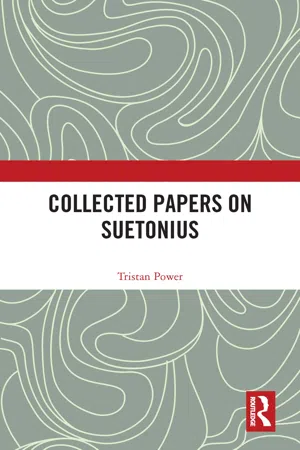
- 320 pages
- English
- ePUB (mobile friendly)
- Available on iOS & Android
Collected Papers on Suetonius
About This Book
This collection of essays by a leading authority on Suetonius, one of our most significant historical sources for the early Roman Empire, provides an in-depth examination of his works, whose literary value has in the past been overlooked.
Although Suetonius is well known for his Lives of emperors such as Caligula and Nero, he is rarely studied in his own right, aside from grammatical or textual commentaries. This is the first volume by an expert on the author to make him accessible to a wider audience, looking at his biographies not only of emperors but also poets, and discovering new contemporary evidence for Jesus from one of Suetonius' first-century sources. Other writers discussed include Homer, Sophocles, Catullus, Virgil, Horace, Curtius Rufus, Josephus, Plutarch, Pliny the Younger, Tacitus, Juvenal, and Cassius Dio. The book contains thirty-two papers in all, eleven of which are new, which examine Suetonius' neglected historical value and literary skills, and offer textual conjectures on both the Illustrious Men and Lives of the Caesars. It also has a new introduction and represents over a dozen years of research on an essential Latin source for Roman history.
Collected Papers on Suetonius provides an invaluable resource for students and researchers working on Suetonius. It also has broader significance for anyone studying Roman imperial history and culture, Latin literature, and classical historiography.
Frequently asked questions
Information
Part I
Illustrious Men
1 Pliny, Letters 5.10 and the Literary Career of Suetonius*
The book [Illustrious Men] is the fruit of long years of scholarly study, and ought to follow the bulk of the less demanding philological and antiquarian essays. In its wake, Suetonius could approach the Caesars with a mind already stocked with information; and this is surely what he did, moving more or less directly from the lives of authors to Caesars.4
Letters 5.10
C. Plinius Suetonio Tranquillo suo s.libera tandem hendecasyllaborum meorum fidem, qui scripta tua communibus amicis spoponderunt. appellantur cotidie, efflagitantur, ac iam periculum est ne cogantur ad exhibendum formulam accipere. sum et ipse in edendo haesitator,8 tu tamen meam quoque cunctationem tarditatemque uicisti. proinde aut rumpe iam moras aut caue ne eosdem istos libellos, quos tibi hendecasyllabi nostri blanditiis elicere non possunt, conuicio scazontes extorqueant. perfectum opus absolutumque est, nec iam splendescit lima sed atteritur. patere me uidere titulum tuum, patere audire describi legi uenire uolumina Tranquilli mei. aequum est nos in amore tam mutuo eandem percipere ex te uoluptatem, qua tu perfrueris ex nobis. uale.Gaius Plinius to his friend Suetonius Tranquillus, greetings.Make good at last on the pledge of my hendecasyllables, which have promised your writings to our mutual friends. They are accosted every day, are met with demands, and are now in danger of being forced to comply with a legal instruction to produce it. I myself am also hesitant to publish, but you exceed my reluctance and lateness too. Therefore, either cease now your delays or take care that those very books of yours, which my hendecasyllables cannot elicit from you by flattery, are not wrenched out by abuse in scazons. The work is finished and complete, and no longer begins to shine from the file but is being worn away. Let me see your cover, and let me hear that my friend Tranquillus’ books are being copied, read, and sold. It is fair that in such shared fondness I take the same delight from you as you enjoy from me. Farewell.
uere nouo, gelidus canis cum montibus humorliquitur et Zephyro putris se glaeba resoluit,depresso incipiat iam tum mihi taurus aratroingemere et sulco attritus splendescere uomer.
In early spring, when the icy liquid flows from the snowy mountains and the crumbling soil is softened by the western wind, let my bull then already begin to groan from the sunken plough, and my ploughshare begin to sh...
Table of contents
- Cover
- Half Title
- Title Page
- Copyright Page
- Dedication
- Table of Contents
- Preface
- Editions and Abbreviations
- Introduction: Suetonius’ Early Life in Pliny’s Letters
- Part I Illustrious Men
- Part II Poetic Allusions
- Part III Textual Conjectures
- Part IV Suetonius and History
- Bibliography
- Index